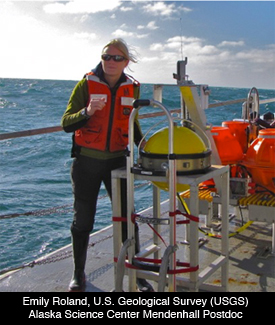US Geological Survey lunch lecture on fault mechanics, May 10
by Jamie Gonzales |
 Thursday, May 10, 11 a.m.-12 p.m.
Thursday, May 10, 11 a.m.-12 p.m.
APU Campus, Glenn Olds Hall, Conference Room (4210 University Drive)
Emily Roland, U.S. Geological Survey (USGS) Alaska Science Center Mendenhall Postdoc,
will present a lecture on oceanic transform faults as a natural laboratory for exploring
fault mechanics.
Roland started at the USGS Alaska Science Center in February. She is working with Peter Haeussler, as well as several folks in the Menlo Park and Seattle offices, focusing on subduction zone earthquakes. Specifically, she is interested in what we can learn about variations in rupture properties along the Alaska-Aleutian megathrust from forearc structure and seismicity observations. Emily did her graduate work at the MIT/WH0I Joint Program, where she focused on observational earthquake and marine active-source seismology. She received her bachelor's degree in geophysical engineering from the Colorado School of Mines.
About the presentation:
Mid-ocean ridge transform faults represent an advantageous tectonic environment for
exploring earthquake rupture mechanics due to their relatively simple geometry, slip
rate and compositional makeup. Until recently, our understanding of earthquake behavior
on oceanic faults has been limited to what we can observe from far-field teleseismic
recordings. In 2008, seismicity associated with the end of the seismic cycle on the
Gofar transform (part of the QDG fault system, 4° South, on the East Pacific Rise)
was recorded by a dense local array of ocean bottom seismographs (OBS). Seismic recordings
reveal dramatic along-strike heterogeneity in fault rupture behavior, illuminating
fault segments that sustain regular, large-magnitude earthquakes and aftershocks and
others that fail during earthquake swarms of tens of thousands of events in a period
of a few days.
Along with information about fault zone material properties from wide-angle seismic refraction data, local earthquake observations provides evidence for important variations in the physical conditions along the fault that likely influence fault slip behavior at transforms, and may be a general feature of these faults globally.
Note: Parking for the event may be tight in the lot adjacent to Glenn Olds and Gould. There is ample additional parking across University Drive between the Carr-Gottstein and Atwood Buildings on the APU campus; the entrance to this parking is on the left just after Gould Hall. Allow a few extra minutes to walk from this lot.
 "US Geological Survey lunch lecture on fault mechanics, May 10" is licensed under a Creative Commons Attribution-NonCommercial 4.0 International License.
"US Geological Survey lunch lecture on fault mechanics, May 10" is licensed under a Creative Commons Attribution-NonCommercial 4.0 International License.









